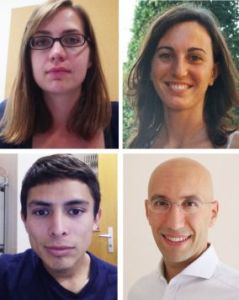Sep 5 2013
A team of University of California, Riverside physicists recently received recognition for their work on the Compact Muon Solenoid (CMS) pixel detector, a particle tracker integral to the study of fundamental particle physics. Martina Malberti, Kira Burt, Manuel Olmedo and Mauro Dinardo make up part of the group responsible for repairing malfunctioning channels in the forward pixel detector.
 Clockwise from top left: Kira Burt, Martina Malberti, Mauro Dinardo and Manuel Olmedo. Recently, approximately 14 percent of the forward pixel detector (CMS experiment) was not working. Due to the efforts of the people pictured here and others, all of the broken channels were fixed. The forward pixel detector is now ready to rejoin global CMS running with all detector channels functional. Photo credit: CERN.
Clockwise from top left: Kira Burt, Martina Malberti, Mauro Dinardo and Manuel Olmedo. Recently, approximately 14 percent of the forward pixel detector (CMS experiment) was not working. Due to the efforts of the people pictured here and others, all of the broken channels were fixed. The forward pixel detector is now ready to rejoin global CMS running with all detector channels functional. Photo credit: CERN.
The group has been working on a project called the CMS experiment, located at the Large Hadron Collider (LHC), part of the CERN complex in Switzerland. The project seeks to uncover new physics that will help to complete the Standard Model of physics, a comprehensive theory that explains the interactions between all fundamental elementary particles, accounting for most measurements to date.
“Basically, we collide protons together and create new particles,” explained John Ellison, a professor of physics and astronomy and collaborator on the CMS project, “Then we look for new physics that arise from those conditions.”
CMS research has already led to the discovery of the Higgs boson earlier this year, and in the future may lead to future evidence for supersymmetry, heavy neutrinos, and extra-spatial dimensions. The CMS pixel detector is essential for such research.
Gail Hanson, a distinguished professor of physics and astronomy and team leader of the project gave details on the repairs. “We are currently in a shut-down period to allow for magnet upgrades that will allow the LHC to achieve its final design energy,” she said. “That has provided us with the opportunity to work on the detector.”
Malberti, an expert on the Higgs boson, began her work on the detector last May; Burt has been with the project since April 2012 and is currently working on supersymmetry; Olmedo, who has been with the project since last fall, is researching the Higgs Boson; and Dinardo, a former postdoctoral researcher at UCR, is an expert on the detector.